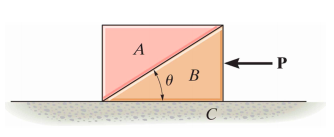Two Blocks Stacked#
Blocks A and B each have a mass \(m\) = 10 \(kg\). The coefficient of static friction between \(A\) and \(B\) is \(\mu_s\) = 0.33. The angle shown is \(\theta\) = 37\(^{\circ}\). Neglect any friction between \(B\) and \(C\).

Question Text#
Determine the largest horizontal force \(\vec{P}\) that can be applied so that \(A\) will not slip on \(B\).
Answer Section#
Please enter in a numeric value in N.
Attribution#
Problem is licensed under the CC-BY-NC-SA 4.0 license.

